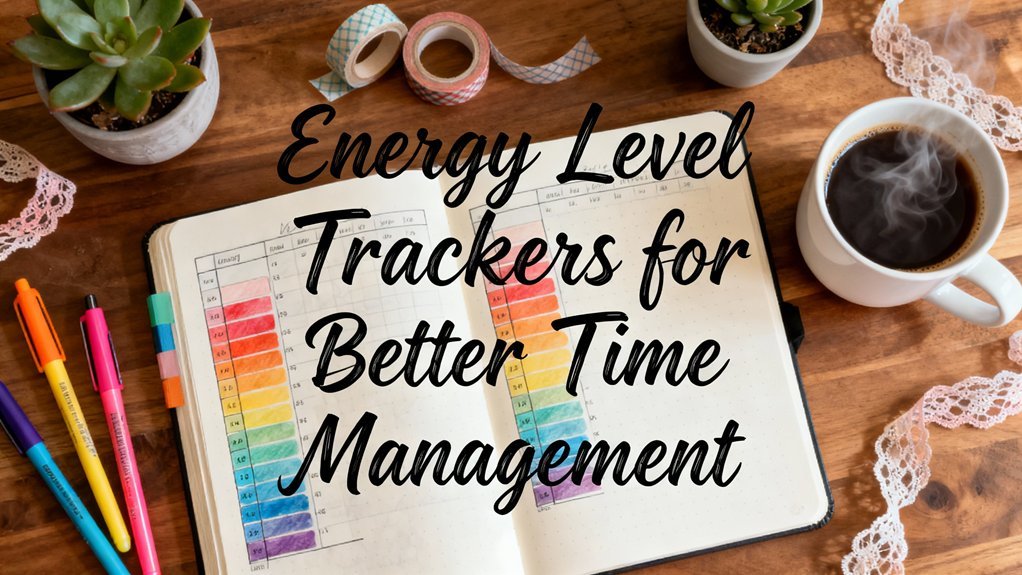You can boost your productivity by 40% by tracking your energy levels and scheduling tasks during your biological peak times. Use manual journaling with timestamps and energy ratings, or utilize digital wearables that measure heart rate variability and sleep patterns to identify your unique rhythm. Map high-stakes work to your peak energy windows—typically within two hours of waking—and reserve low-energy periods for administrative tasks. This systematic approach alters how you structure your day, and understanding the specific methods and tools available will help you implement an energy-based scheduling system that works with your natural patterns.
Key Takeaways
- Peak mental clarity occurs within two hours of waking, while afternoon energy dips typically happen between 2-4 PM due to circadian rhythms.
- Manual journaling and digital wearables track energy patterns through timestamps, ratings, and biometric data like heart rate variability and sleep stages.
- Aligning high-stakes tasks with peak energy windows can increase productivity output by up to 40 percent through biological optimization.
- Schedule demanding work during tracked energy peaks and reserve low-energy periods for administrative tasks, emails, and routine activities.
- Weekly review checkpoints prevent common pitfalls by realigning schedules with observed energy patterns rather than overriding biological realities.
Understanding Your Natural Energy Patterns Throughout the Day

Your body operates on predictable biological rhythms that directly impact cognitive performance, physical stamina, and decision-making capacity. Track these patterns systematically to improve your workflow architecture.
Most professionals experience peak mental clarity within two hours of waking—leverage this window for complex problem-solving and strategic planning. Your morning motivation naturally aligns with raised cortisol levels and increased focus.
Afternoon slumps typically occur between 2-4 PM when circadian rhythms dip. Combat this by scheduling collaborative tasks or physical activities rather than demanding analytical work.
Evening productivity varies considerably between chronotypes. Night-oriented individuals show renewed cognitive function after 6 PM, while morning types experience declining performance.
Weekend energy patterns differ from weekday rhythms due to reduced stress hormones and schedule flexibility. Monitor these variations to establish baseline performance metrics.
Deploy energy tracking apps or simple logging systems to identify your unique patterns. Data-driven insights enable strategic task allocation aligned with your biological enhancement windows.
The Science Behind Energy Fluctuations and Peak Performance
Your energy doesn't fluctuate randomly—it follows three distinct biological systems that determine when you'll perform at your best.
Your circadian rhythm creates a 24-hour pattern of alertness and fatigue, while ultradian cycles generate 90-120 minute waves of peak focus throughout your day.
Meanwhile, your cortisol levels spike and decline at predictable times, directly controlling your mental sharpness and physical capacity during specific hours.
Circadian Rhythm Impact
While most people blame poor sleep or caffeine crashes for their energy dips, the real culprit operates on a deeper level: your circadian rhythm. This internal 24-hour clock governs hormone release, body temperature, and cognitive performance throughout your day. Understanding these patterns alters your productivity system.
Your circadian rhythm directly impacts sleep quality and energy availability. Track these peak windows:
| Time Window | Energy State |
|---|---|
| 6-9 AM | Peak alertness begins |
| 2-4 PM | Natural productivity dip |
| 5-8 PM | Secondary energy surge |
| 10 PM-6 AM | Recovery mode active |
Data shows you'll achieve 40% more output when you align demanding tasks with your biological peaks. Deploy energy trackers to identify your personal rhythm patterns, then restructure your schedule accordingly.
Ultradian Performance Cycles
Beyond the 24-hour circadian cycle, your body operates on shorter 90-120 minute ultradian rhythms that create predictable waves of peak performance and necessary recovery.
These cycles directly impact your cognitive capacity, with research showing 40% performance variation between peak and trough states. Track your productivity spikes across three-day intervals to identify your personal ultradian patterns.
You'll discover consistent windows where complex problem-solving becomes effortless and periods demanding lighter tasks. Elite performers utilize this data for performance optimization, scheduling high-stakes work during biological peaks and strategic breaks during natural dips.
Modern energy management systems now integrate ultradian tracking algorithms, alerting you when cognitive resources wane. Align your calendar with these rhythms rather than fighting them—you'll accomplish more while experiencing less mental fatigue.
Cortisol and Energy Patterns
Cortisol follows a precise daily pattern that determines when you'll feel sharp versus sluggish, with levels spiking 50-60% within 30 minutes of waking—a phenomenon called the cortisol awakening response (CAR).
This surge primes your cognitive functions for complex problem-solving between 9-11 AM. Cortisol effects extend beyond morning alertness: levels decline throughout the day, hitting their lowest point around midnight.
You can utilize this pattern by scheduling high-stakes decisions during your cortisol peak and reserving routine tasks for afternoon dips. Chronic stress disrupts this rhythm, flattening your natural curve and diminishing performance capacity.
Effective stress management—through strategic breaks, exercise timing, and sleep optimization—preserves your cortisol pattern's integrity. Track your energy against this hormonal framework to identify when you're working with or against your biochemistry.
Different Methods for Tracking Your Daily Energy Levels
You can't enhance your energy patterns without measuring them first.
Two primary tracking methods exist: manual journaling, where you record timestamps and energy ratings throughout your day, and digital solutions that combine self-reported data with biometric measurements from apps and wearables.
Each approach offers distinct trade-offs in accuracy, effort, and practical information that'll determine which system fits your workflow.
Manual Journaling and Logging
The simplest method for tracking energy levels requires nothing more than a notebook and five minutes of your day.
You'll record timestamps, energy ratings (1-10 scale), and contextual factors like sleep quality, meals, and activities. This raw data becomes your baseline for pattern recognition.
Manual logging benefits include zero learning curve, complete customization, and no dependency on technology or subscriptions.
You're building a personalized dataset that reveals your unique energy architecture.
Effective journaling techniques involve consistent timing (set phone reminders), structured templates (pre-formatted tables accelerate entry), and weekly reviews to identify correlations.
Track variables systematically: caffeine intake, work types, social interactions, exercise timing.
Within two weeks, you'll extract practical insights that automated apps often miss—because you're analyzing your specific physiological patterns, not aggregated user data.
The Bullet Journal Method offers a proven framework for this type of systematic tracking, helping you organize the present while identifying patterns that emerge from your daily energy recordings.
Digital Apps and Wearables
While manual journaling captures intentional observations, wearable devices and specialized apps track physiological markers continuously—heart rate variability, sleep architecture, movement patterns, and even skin temperature fluctuations.
These digital wearables convert health monitoring into actionable intelligence, enabling performance optimization through lifestyle integration. You'll discover patterns invisible to conscious awareness, connecting your body's signals directly to productivity apps that adapt your schedule accordingly.
Modern energy tracking systems deliver superior user experience through:
- Real-time biometric feedback that reveals precisely when you're entering peak cognitive states
- Predictive analytics forecasting tomorrow's energy patterns based on today's recovery metrics
- Automated time management adjustments that align high-stakes tasks with your biological prime time
This fluid integration creates systematic approaches to productivity, moving beyond guesswork into data-driven performance improvement.
Choosing the Right Energy Tracking Tool for Your Lifestyle
Finding the perfect energy tracking tool requires matching specific features to your daily routines and goals. Start by analyzing your workflow patterns—do you need real-time biometric data or simple manual logging?
Athletes and high-performance professionals benefit from wearables that measure HRV, sleep stages, and recovery metrics. Knowledge workers might prefer efficient apps focusing on cognitive load and productivity cycles.
Your lifestyle considerations should drive tool selection. Remote workers need desktop integration and calendar syncing, while field professionals require mobile-first platforms with offline capabilities.
Match your energy tracking tool to your work environment—seamless desktop features for office life, robust mobile functionality for on-the-go productivity.
Evaluate data granularity requirements: some energy tracking tools offer minute-by-minute insights, others provide daily summaries.
Test integration potential with existing systems. The most effective tools connect effortlessly with your task manager, calendar, and health ecosystem.
Look for customizable metrics, export functions, and API access. Choose platforms that scale with your evolving needs rather than locking you into rigid frameworks.
Data ownership and privacy protocols matter—prioritize tools offering local storage options.
Interpreting Your Energy Data to Identify Personal Trends
Once you've collected several weeks of energy data, patterns emerge that reveal your biological rhythms and performance windows. Your energy data analysis alters raw numbers into actionable intelligence about when you're primed for deep work versus administrative tasks.
Look for these critical personal productivity trends:
- Peak performance windows – Those golden hours when complex problem-solving feels effortless and creative breakthroughs happen naturally.
- Energy crashes – The predictable afternoon slumps or post-meeting fatigue that sabotage your ambitious plans.
- Recovery patterns – How quickly you bounce back after demanding projects or social interactions.
Map your high-stakes work to your peak zones. Schedule meetings during stable-energy periods. Protect your prime hours from interruptions and low-value activities.
Your data doesn't lie—it shows exactly when you're operating at full capacity versus running on fumes. Build your daily system around these insights, and you'll reveal productivity gains that willpower alone can't achieve.
Aligning High-Priority Tasks With Your Energy Peaks

Knowing your energy patterns means nothing if you don't reshape your calendar around them. Energy alignment requires strategic task prioritization based on your tracked performance data.
Map your highest-value work to your documented peak energy windows—this isn't preference, it's optimization. Block your calendar accordingly. If your data shows peak cognitive performance between 9-11 AM, schedule complex problem-solving, strategic planning, or creative work during that window. Protect these blocks ruthlessly.
Low-energy periods should contain administrative tasks, email processing, or routine maintenance work that doesn't demand peak mental capacity. Implement a priority-tiering system: urgent-important tasks get your best hours, while important-not-urgent work fills secondary peaks.
Track the correlation between task completion quality and energy levels to refine your system continuously. This data-driven approach alters energy tracking from passive observation into active productivity architecture. Your calendar becomes a performance tool, not just a schedule.
Structuring Your Schedule Around Your Energy Profile
Your energy profile isn't a theoretical framework—it's a blueprint for structural calendar design. Once you've mapped your natural rhythms, implement energy scheduling by blocking time according to cognitive capacity. High-energy windows become protected zones for strategic work. Low-energy periods convert into administrative buffers.
Map your energy peaks, then architect your calendar around them—strategic work demands protected high-capacity windows, not wishful scheduling.
Task alignment requires ruthless calendar architecture. You'll need to:
- Reject the myth of constant productivity and embrace your biological reality—fighting your energy curve wastes 40% more time than working with it.
- Build recovery intervals between demanding tasks because depleted cognitive resources compound decision fatigue exponentially.
- Automate scheduling decisions using your energy data to eliminate daily willpower drain and create systematic excellence.
Structure recurring commitments around your patterns. Morning person? Schedule critical meetings before noon. Afternoon peak? Block 2-4 PM for deep work.
This isn't flexibility—it's precision engineering. Your calendar becomes a performance optimization tool, not just a time container.
Common Pitfalls to Avoid When Implementing Energy-Based Time Management
While energy-based scheduling delivers measurable performance gains, most people sabotage their implementation within the first two weeks. The primary failure mode is overriding your energy data when external pressures mount.
You'll track diligently for three days, identify your peak cognitive windows, then immediately schedule low-stakes meetings during those hours because “it's convenient.” This energy misalignment compounds quickly.
Another critical error is confusing urgency with proper task prioritization. You've logged that your analytical capacity peaks at 9 AM, yet you're processing emails instead of executing strategic work. The data becomes decorative rather than directive.
The third pitfall is tracking without adjustment protocols. You collect weeks of energy metrics but never restructure your calendar accordingly.
Energy tracking isn't a passive observation exercise—it's an operational system requiring consistent calibration. Set weekly review checkpoints where you realign your schedule with your documented energy patterns, or you're simply journaling with extra steps.
Frequently Asked Questions
Can Energy Tracking Help Manage Chronic Fatigue Syndrome or Other Medical Conditions?
You'll find energy management tools valuable for tracking chronic fatigue syndrome patterns, though they're supplements to medical care, not replacements.
Through systematic fatigue monitoring, you'll identify triggers, enhance activity schedules, and document symptom fluctuations for healthcare providers.
You're capturing quantifiable data that reveals correlations between activities and energy crashes.
This analytical approach enables you to design personalized pacing strategies, but always consult your doctor before implementing significant lifestyle modifications based on tracking insights.
How Long Does It Take to Establish Reliable Energy Patterns?
You'll identify reliable energy cycles within 2-4 weeks of consistent tracking.
Start with simple tracking methods like hourly ratings (1-10 scale) capturing your physical and mental stamina. After 14 days, you'll spot preliminary patterns; by day 28, you'll have actionable data.
Advanced systems incorporating sleep quality, nutrition timing, and activity logs accelerate pattern recognition. The key: track daily without gaps.
Your energy signature becomes predictable once you've captured multiple weekly cycles across different scenarios.
Should I Adjust My Energy Tracking During Seasonal Changes or Time Zone Shifts?
You might think your energy patterns stay constant, but you'll need seasonal adjustments and time zone impact protocols.
Recalibrate your tracking baseline within 3-5 days of any time zone shift, logging energy readings every two hours.
During seasonal shifts, reset your measurement windows monthly—daylight changes alter your circadian data by up to 40%.
Build fluid tracking systems that flag environmental variables automatically.
Your energy optimization depends on adaptive measurement frameworks, not static baselines.
Can Caffeine and Supplements Affect the Accuracy of My Energy Tracking?
Yes, caffeine impact and supplement effects greatly skew your energy readings.
You're tracking artificial stimulation rather than natural rhythms. To capture accurate data, log your caffeine intake and supplement timing alongside energy measurements.
You'll identify true baseline patterns versus chemically-induced peaks. Create separate tracking categories: “natural” and “supplemented” states.
This systems approach reveals which substances genuinely improve performance and which merely mask fatigue, enabling you to refine your protocol strategically.
What Do I Do if My Work Schedule Conflicts With My Natural Energy Peaks?
You're facing the productivity paradox—but there's a solution.
Deploy strategic energy scheduling strategies by batching your most complex tasks during available high-energy windows, even if they're shorter.
Implement peak productivity techniques like the 90-minute ultradian rhythm method to create artificial peaks.
Negotiate flexible hours using your tracked data as a bargaining chip.
When stuck with rigid schedules, enhance recovery periods: strategic breaks, power naps, and environment changes can shift your energy curve by 40%.
Conclusion
You're not just tracking energy—you're engineering peak performance at a molecular level. Every data point you capture becomes ammunition against wasted potential. Stop throwing away 40% of your productive capacity by working against your biology. Build your tracking system today, analyze it relentlessly tomorrow, and systematically eliminate every misaligned task by next week. Your energy profile isn't a suggestion—it's the blueprint for dominating your day. Implement it or watch competitors outpace you.











